Forest Tree species
Silver fir (Abies alba Mill.)
Order: Pinales
Family: Pinaceae
Genus: Abies
Species: Abies alba
Abies alba Mill. is a long-living conifer and the largest tree (up to 60 m) in the genus Abies in the Europe. It is shade tolerant and able to act as a “seedling bank” under the canopy of older dominant trees for decades. The tree usually grows in altitudes from 500-2000 m and favours deep, nutrient-rich and well-drained soils. Among the different fir species growing naturally in Europe, silver fir is the most important in terms of economic and ecological significance. The strong, lightweight timber is mainly used for construction, furniture, plywood and pulpwood. Young trees are also popular as Christmas trees. Ecologically, the tree is important for maintaining high biodiversity in forested areas.
LIFE SySTEMiC includes 5 demonstration sites of this species: one is in Croatia and two in Italy and in Slovenia.
Distribution
The distribution area is limited mainly to the mountainous regions of eastern, western, southern and central Europe


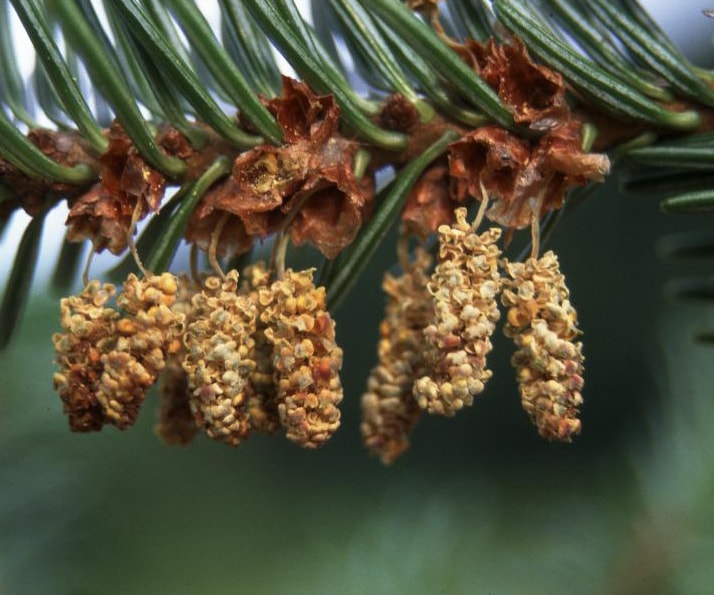  |   | 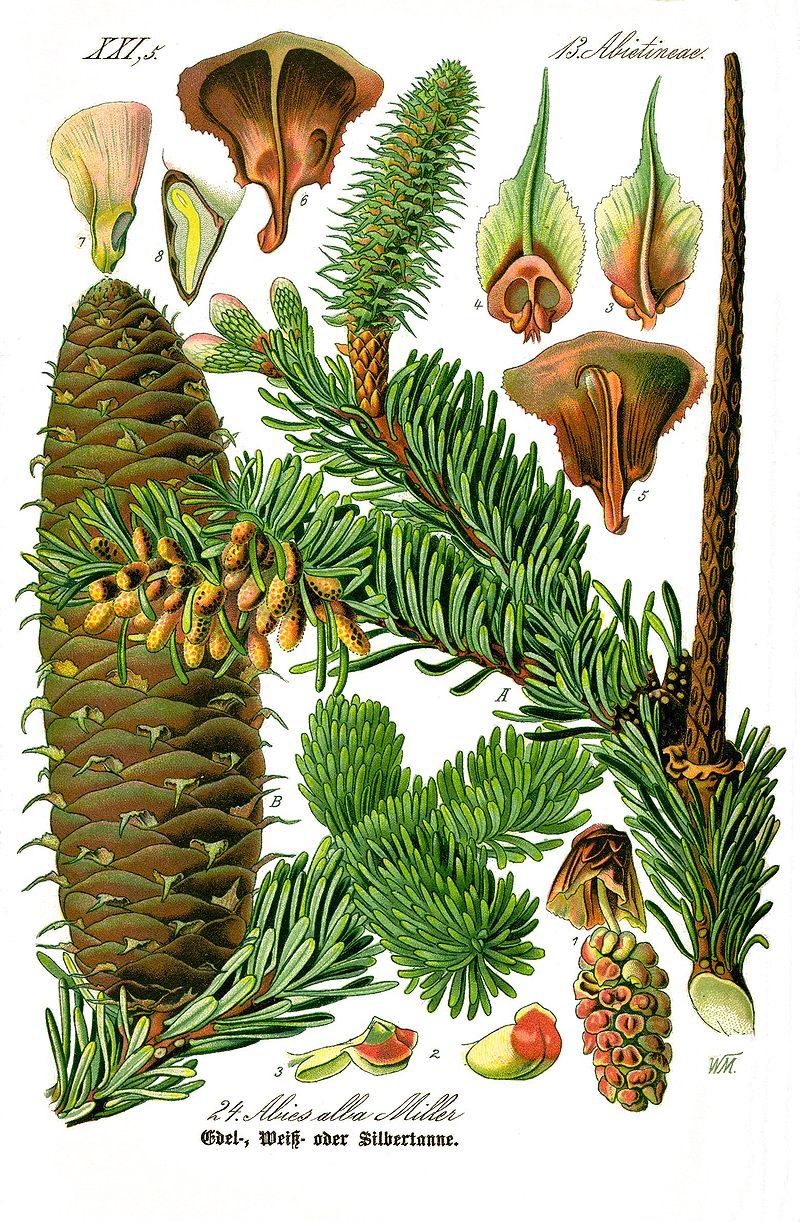  |
Fig. Abies alba flowers and foliage of silver fir (Credit: C.Giordano/EUFORGEN), Botanical illustration Abies alba (Source: Prof. Dr. Otto Wilhelm Thomé Flora von Deutschland, Österreich und der Schweiz 1885, Gera, Germany; Author: Walther Otto Müller).
European beech (Fagus sylvatica L.)
Order: Fagales
Family: Fagaceae
Genus: Fagus
Species: Fagus sylvatica
Fagus sylvatica L. is a large deciduous tree capable of reaching heights of up to 50 m. This species favor a humid atmosphere and well-drained soils, which its roots can easily penetrate. On favorable sites, beech is widely distributed as it out-competes other tree species due to its excellent tolerance to shade. With around 250 known uses for its wood, beech is one of the most important and diversely used trees in Europe. The wood is highly appreciated for use in furniture, flooring, staircases and musical instruments, as well as for plywood, veneering and pulp. Due to its high energetic potential, beech is also coppiced for firewood and charcoal. The tree further provides nourishment to several birds and animals, especially when fruiting occurs, every 5 to 8 years.
LIFE SySTEMiC includes 11 demonstration sites of this species: one is in Croatia, seven are in Italy and three are in Slovenia.
Distribution
European beech is widely distributed in Central and Western Europe.


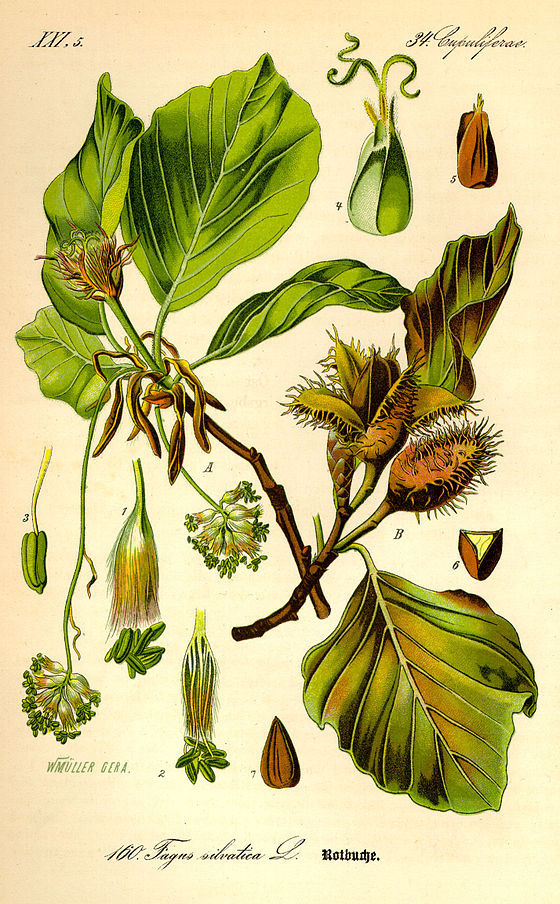  |   |
Fig. Botanical illustration (Source: www.biolib.de; Original book source: Prof. Dr. Otto Wilhelm Thomé Flora von Deutschland, Österreich und der Schweiz 1885, Gera, Germany ) Leaves of Fagus sylvatica L. (Credit: Daniel Baránek/Wikimedia/EUFORGEN).
Black pine (Pinus nigra J.F.Arnold)
Order: Pinales
Family: Pinaceae
Genus: Pinus
Subgenus: P. subg. Pinus
Section: P. sect. Pinus
Subsection: P. subsect. Pinus
Species: Pinus nigra J.F. Arnold
Pinus nigra J.F.Arnold is a large coniferous evergreen tree, growing to 20–55 m high at maturity and spreading to 20 to 40 feet wide. The bark is grey to yellow-brown, and is widely split by flaking fissures into scaly plates, becoming increasingly fissured with age. The ovulate and pollen cones appear from May to June. The wood is durable, rich in resin and easy to process, which makes it suitable for indoor flooring, general construction and furniture. Due to its ability to tolerate pollution, as well as its interesting visual form, the tree is additionally used as an ornamental in urban and industrial contexts. Other uses include Christmas trees, fuelwood and poles. Black pine is a light-demanding species and is shade-intolerant, but resistant to wind and drought. It is effective for controlling soil erosion and landslides and is widely used for reforestation. There are a wide range of subspecies of the black pine, each with specific preferred habitat conditions in terms of soil and climate.
LIFE SYSTEMiC includes three demonstration sites of this species: two are in Croatia and one is in Slovenia.
Distribution
Pinus nigra J.F. Arnold has wide but scattered distribution across Europe and Asia Minor, mainly found in mountain areas.


  |   |
Fig. Habitus of Pinus nigra J.F.Arnold (Credit: Jean-Pol GRANDMONT/WIKIPEDIA) and botanical illustration (Author: Franz Eugen Köhler, Köhler’s Medizinal-Pflanzen).
Stone pine (Pinus pinea L.)
Order: Pinales
Family: Pinaceae
Genus: Pinus
Subgenus: P. subg. Pinus
Section: P. sect. Pinus
Subsection: Pinus subsect. Pinaster
Species: Pinus pinea L.
Stone pine, also known as Italian stone pine and umbrella pine is a medium-sized coniferous tree. Stone pine is mainly known and is commercially important for its highly nutritional and edible seeds: pine nuts. The tree’s wood is of low quality but used locally for furniture, while the resin is tapped and used for rosin. Other uses include stabilisation of sand dunes and as an ornamental in warmer regions in Europe. Stone pine grows well in dry and sunny areas with high temperatures but is also able to tolerate frost. Despite low genetic diversity, the species grows on a wide range of different soils and climatic conditions. It prefers sandy, acidic soils but tolerates calcareous ones, as well. Its growth, though, is limited on very loamy soils.
LIFE SYSTEMIC includes three demonstration sites of this species: one is in Croatia and two are in Italy.
Distribution
The natural distribution of Italian stone pine is near the Mediterranean basin, extending from Portugal to Syria.


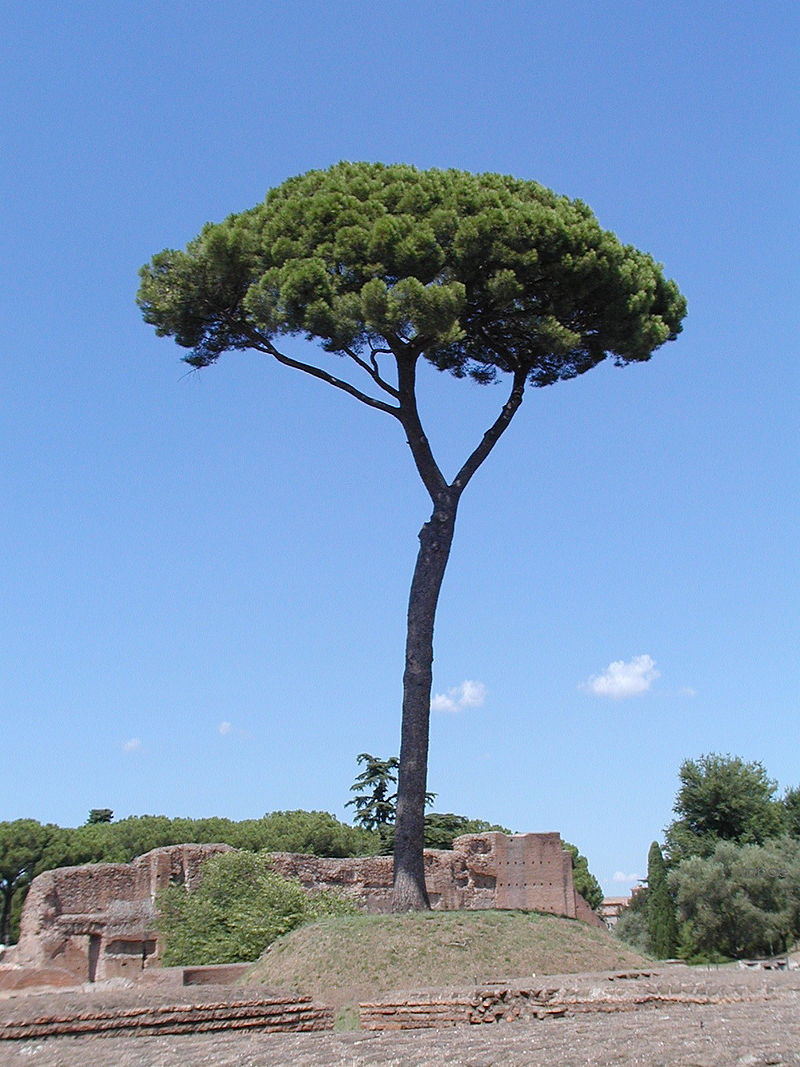  |   |
Fig. Stone pine habitus (Author: Ra Boe/WIKIPEDIA) and cones (Credit: Unknown photographer/Wikimedia/EUFORGEN).
Maritime pine (Pinus pinaster Aiton)
Order: Pinales
Family: Pinaceae
Genus: Pinus
Subgenus: P. subg. Pinus
Section: P. sect. Pinus
Subsection: Pinus subsect. Pinaster
Species: Pinus pinaster Aiton
Pinus pinaster Aiton, the maritime pine or cluster pine, is medium-sized coniferous tree native to the western Mediterranean Sea. It has been cultivated and is now naturally found in other parts of central and southern Europe and in North Africa. The wood is used for constructions, furniture and poles, while its resin is tapped to make rosin and turpentine. Other uses include stabilisation of dunes and slopes, as shelterbelts near coastal areas and for production of plant nursery substrates. The light-demanding tree includes several different subspecies with high genetic diversity and is found in a wide ecological range. Originally, the tree grew in warm and humid regions but, as a result of many years of cultivation and adaptation outside its natural range, it is now able to tolerate various conditions, including frost, summer drought and calcareous and poor soils. It grows in altitudes between sea level and 2000 m in pure or mixed stands. Maritime pine is considered invasive in the southern hemisphere.
LIFE SYSTEMiC includes one demonstration site of this species, which is located in Croatia.
Distribution
Its range is in the western Mediterranean Basin, extending from Portugal and Northern Spain (especially in Galicia) to southern and Western France, east to western Italy, Croatia and south to northern Tunisia, Algeria and northern Morocco. It favors a Mediterranean climate, which is one that has cool, rainy winters and hot, dry summers.


  |   |
Fig. Branches (No machine-readable author provided/Wikipedia) and cones (Credit: MGR/WIKIMEDIA/ EUFORGEN) of Pinus pinaster.
Downy oak (Quercus pubescens Willd.)
Order: Fagales
Family: Fagaceae
Genus: Quercus
Subgenus: Quercus subg. Quercus
Section: Quercus sect. Quercus
Species: Quercus pubescens Willd.
Quercus pubescens Willd., downy oak or pubescent oak is a medium-sized deciduous or semi deciduous tree, growing up to 20 m, often found in crossbreeds with other oaks. The tree’s wood is inferior when compared to many other oak species; hence, it is mainly used for firewood and only occasionally for carpentry, boat-building and packaging. The tree also serves as a host for economically important truffles. Downy oak prefers well-drained lime soils but also grows on acidic soils in warmer areas. It is usually found on hillsides between 200-800 m but is very adaptable and grows from sea level up to 1300 m. The species is both able to withstand frost in the winter and drought in the summer.
LIFE SySTEMiC includes one demonstration site of this species, which is located in Slovenia
Distribution
Quercus pubescens, is native to southern Europe and southwest Asia, from northern Spain (Pyrenees) east to the Crimea and the Caucasus. It is also found in France and parts of central Europe.
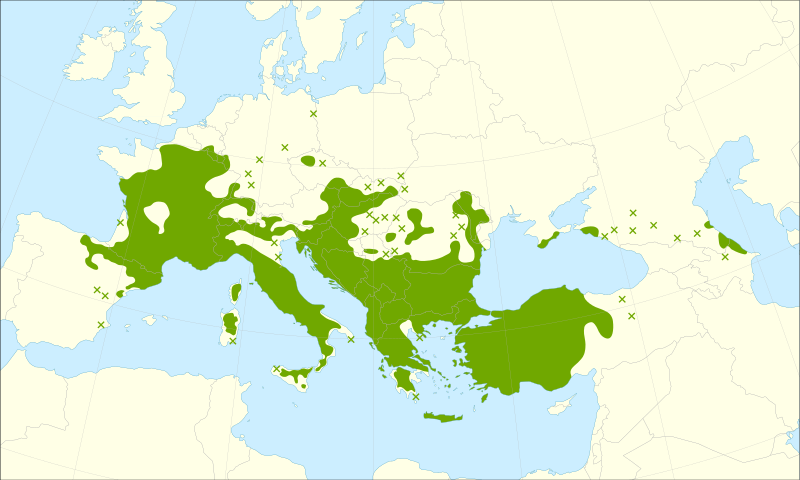

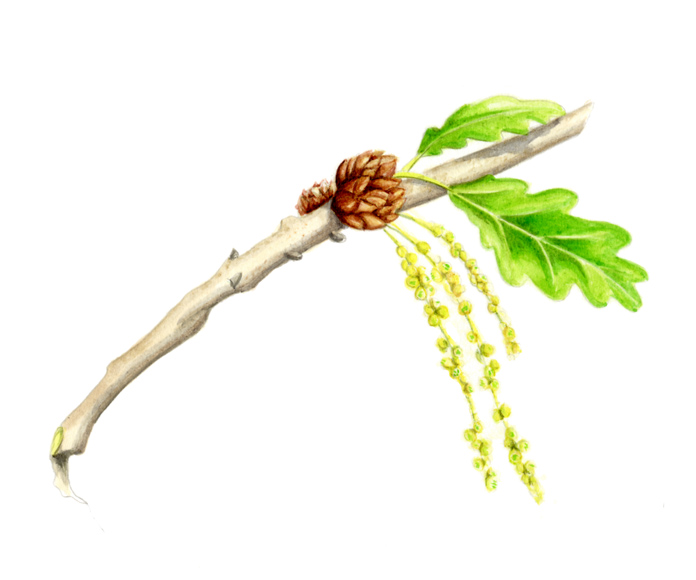  |   |   |
Fig. Ilustration of leaves, flowers and acorn of Quercus pubescens Willd. (Credit: G. Bernetti/EUFORGEN). Leaves of Quercus pubescens Willd. (Credit: Franz Xaver/WIKIPEDIA)
Pedunculate oak (Quercus robur L.)
Order: Fagales
Family: Fagaceae
Genus: Quercus
Subgenus: Quercus subg. Quercus
Section: Quercus sect. Quercus
Species: Quercus robur L.
Quercus robur L., commonly known as common oak, pedunculate oak, European oak or English oak, is large, long-lived deciduous tree, widely distributed in Europe. It is one of the most economically and ecologically important deciduous forest tree species in Europe. The wood from oaks is hard and durable and valued for several purposes including for construction, furniture, veneer, fencing and firewood. It has a high tannin content, which makes it resistant to insect and fungal attacks and is particular useful for wine and spirit barrels. Oak species also have an important ecological role, as they support insects and their acorns provide a valuable food source for many birds and mammals. The canopy of oaks allows a fair amount of light to pass through, permitting a diverse and enriched understory. Pedunculate oak is very tolerant to soil conditions and the continental climate. It can be found in periodic wet areas by streams and rivers, but prefers fertile and well-watered soils. Pedunculate oak is a pioneer species in plains and hills, while it is a late successional species in valleys and floodplains.
LIFE SYSTEMiC includes three demonstration sites of this species: one is located in Slovenia, one in Italy and one in Croatia.
Distribution
It is native to most of Europe west of the Caucasus.
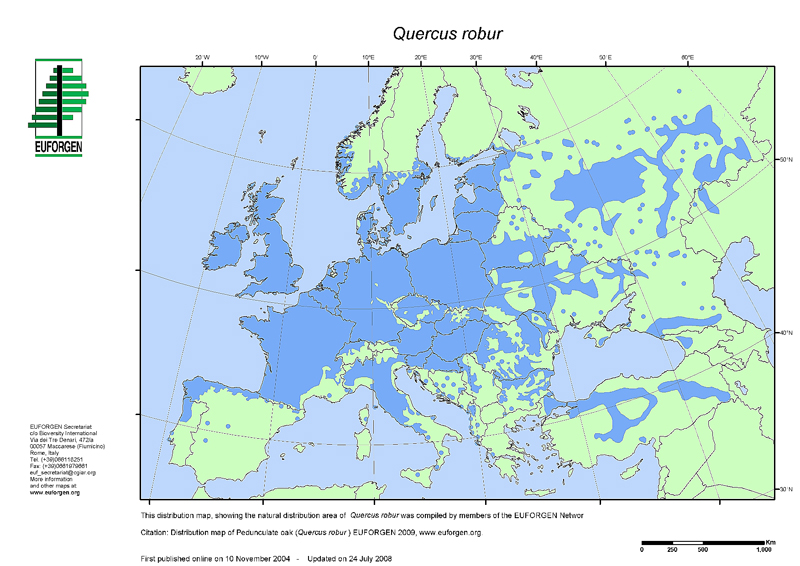

  |   |   |
Fig. Leaves of Quercus robur L. (Credit: 4nuc/Wikimedia/EUFORGEN); Acorns of Quercus robur L. (Credit: Twid/Wikimedia/EUFORGEN); Flowers of Quercus robur L. (Credit: Simon Eugster/Wikimedia/EUFORGEN)
Holm oak (Quercus ilex L.)
Order: Fagales
Family: Fagaceae
Genus: Quercus
Subgenus: Quercus subg. Quercus
Section: Quercus sect. Cerris
Species: Quercus ilex L.
Quercus ilex L., the evergreen oak, holly oak or holm oak is a small to medium-sized, long-living evergreen tree characterized by its leathery and woolly leaves. The tree’s wood is hard and only used for smaller woodcrafts, such as handles and carpentry tools. It is usually managed as coppice forest, mainly for the production of firewood. Traditionally, the tree was planted in pastures and provided acorns to grazing livestock. The acorns are still used as fodder for pigs and are a food source for several other wild animals. Holly oak is shade-tolerant and able to germinate and re-sprout in the understorey of woodlands. It grows well on many different soils and is able to handle various climates in the Mediterranean, from warm to very cold conditions in high altitudes.
LIFE SYSTEMiC includes one demonstration site of this species, which is located in Croatia.
Distribution
It is native to the central-western part of the Mediterranean, where it is often found in mixed vegetation, together with other broadleaved evergreen plants.


  |
Fig. Leaves of Quercus ilex L. (Credit: Fritz Geller-Grimm/Wikimedia/EUFORGEN).

